You’ve got the tech and the team to revolutionize defense, but somehow, you’re still flying under the radar.
Sounds familiar?
Well, it’s not your tech; it’s your brand.
That’s where I come in.
I’m Viktor, a strategist and I’ve spent over a decade diving deep into the world of strategy, working with the crème de la crème of brands and companies.
And yes, I’ve been obsessed with military history since I was a kid, which means I get your world more than most.
So, why is branding as crucial as your next big tech breakthrough in defense? Imagine having the most advanced tech but being invisible in the market.
That’s a no-go in an industry where reputation and visibility can open government vaults.
Branding isn’t just about a logo or a tagline; it’s about telling your story in a way that resonates, building trust, and standing out in a sea of sameness.
The global defense sector is projected to grow significantly in the coming years, but only those with a solid brand strategy will truly capitalize on this boom.
In this guide, we’ll dive deep into creating a branding strategy that makes you not just seen, but sought after.
From understanding your unique brand essence to crafting a narrative that captivates, we’re covering all bases.
Let’s go.
Hold on. Before you read on and spend weeks building a strategy…
Consider doing what 100s of CEO’s and founders did. Let me help you with your strategy and save 60+ hours of your time.
Book a 30 min, free, non obligatory callThe least you will get is 10 actionable tips & strategies, worth $5999, for free.
Superb
★★★★★“It was great working with Viktor! Thoughtful, strategic, great listener and really gets the client’s requirement. Highly recommend and hopefully can work together again soon. Definitely went above and beyond!”
Robin Singvi, CEO of SmartCue, a leading company developing products for go-to market teams worldwide.
Understanding the Defence Landscape
A. Current Brand Strategy Trends in the Defense Sector
The defense industry is witnessing a seismic shift in branding strategies, moving beyond traditional government contracts and procurement processes.
We’re seeing an increased focus on digital presence and thought leadership, as defense companies strive to differentiate themselves in a highly competitive market.
There’s a growing emphasis on storytelling, showcasing not just the technical excellence but also the mission and vision that drive these companies.
Integrating advanced technologies like AI and VR into marketing efforts to simulate experiences and capabilities is on the rise.
Furthermore, sustainability and corporate responsibility are becoming key components of brand narratives, reflecting global concerns and values.
B. Challenges and Opportunities
Navigating the defense sector’s brand strategy landscape comes with its unique set of challenges and opportunities.
On one hand, stringent regulations and the sensitive nature of defense products limit marketing strategies.
There’s also the challenge of breaking through the noise and making complex technologies relatable to a broader audience.
On the flip side, the growing global defense expenditure, projected to reach over $2 trillion by 2023, presents significant opportunities.
There’s an increasing demand for defense companies to not only showcase their technological prowess but also their role in global security and innovation.
Emphasizing ethical considerations and how defense technologies contribute to a safer world can resonate deeply with modern audiences.
Moreover, the digital transformation offers new avenues for engagement, from immersive tech demonstrations to strategic content marketing, allowing defense brands to build more profound connections with their stakeholders.
Types defence company businesses by vertical
In the defense sector, brand strategy can diverge significantly across various verticals, each tailored to address specific market demands and stakeholder expectations. Here’s a quick rundown:
- Defense Manufacturing: Focused on highlighting technological superiority, innovation, and reliability. Branding strategies here emphasize a legacy of trust and cutting-edge solutions to appeal to government and private contractors.
- Cybersecurity Defense: Prioritizes the showcasing of intelligence, agility, and advanced threat detection capabilities. Brands in this vertical use strategies that underline their role in national security and the protection of critical infrastructure.
- Aerospace Defense: Emphasizes innovation in aviation technology, space exploration, and satellite communications. Brand strategies are often built around the themes of exploration, safety, and strategic partnerships that push the boundaries of what’s possible.
- Naval Defense: Focuses on maritime security, showcasing capabilities in shipbuilding, submarine technology, and coastal defense systems. Branding in this sector often highlights durability, strategic dominance, and technological innovation in harsh environments.
- Land Systems Defense: Concentrates on mobility, firepower, and protection in land warfare. Brands strategize around reliability, support, and the integration of ground-breaking technologies in vehicles and equipment to ensure ground forces’ superiority.
Each vertical requires a nuanced approach to branding, addressing the unique challenges and opportunities within its domain to connect effectively with its specific audience segments.
Essential Elements of a Defence Company Brand Strategy
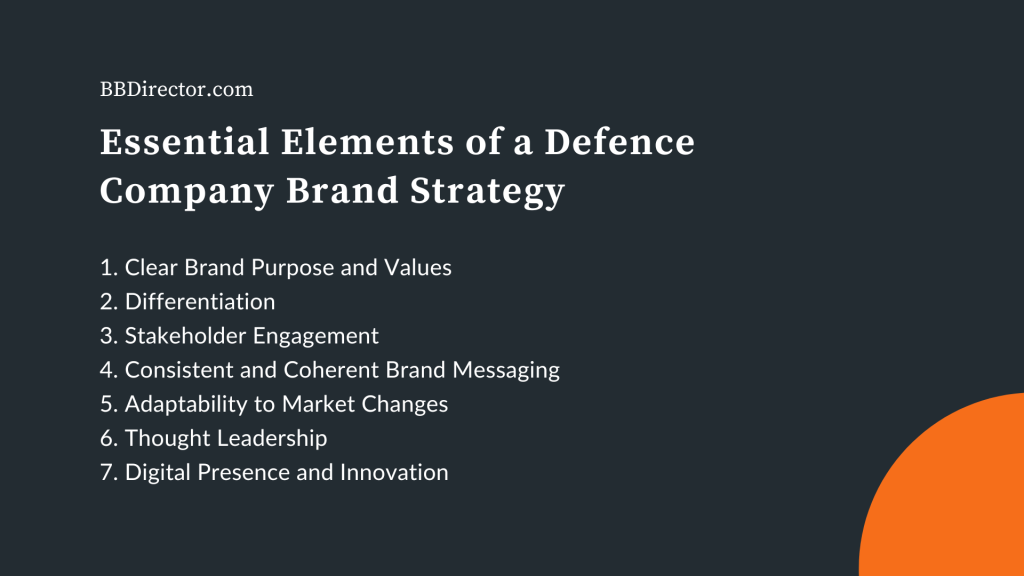
Crafting an effective brand strategy in the defense sector involves several critical elements that align with both the unique challenges of the industry and the expectations of its stakeholders.
Here are the essential components:
1. Clear Brand Purpose and Values
A defense company must articulate a clear purpose that goes beyond profit — such as innovation in national security, commitment to ethical standards, or contributions to global stability.
Studies, including those by Deloitte, emphasize that companies with a well-defined purpose enjoy higher market share gains and grow three times faster on average than their competitors.
2. Differentiation
In a sector as competitive as defense, standing out is crucial.
Differentiation could be based on technological innovation, customer service, product quality, or sustainability practices.
The Boston Consulting Group highlights that companies that innovate new products and business models tend to outperform their peers in revenue growth and market share.
3. Stakeholder Engagement
Defense companies operate in a complex ecosystem with multiple stakeholders, including government entities, private contractors, and the public.
Effective engagement strategies involve transparent communication, CSR initiatives, and community involvement.
According to a report by McKinsey, companies that lead in customer engagement strategies tend to outperform their peers by 85% in sales growth.
4. Consistent and Coherent Brand Messaging
Consistency across all platforms and communications reinforces brand recognition and trust.
A study by Lucidpress found that brand consistency can increase revenue by 33%.
For defense companies, this means ensuring that all marketing materials, proposals, and digital content reflect the brand’s core message and values uniformly.
5. Adaptability to Market Changes
The defense industry is subject to rapid changes due to technological advancements and geopolitical shifts.
Brands that remain flexible and adapt their strategies accordingly are more likely to succeed.
A report by PwC suggests that agility and adaptability are key drivers of success in high-stakes industries, including defense.
6. Thought Leadership
Establishing your brand as a thought leader in specific defense niches can significantly enhance credibility and authority.
Producing insightful content, participating in industry forums, and conducting original research are effective ways to achieve this.
Forbes states that thought leadership is a powerful tool for building brand value, with 58% of decision-makers choosing a business based on its thought leadership credentials.
7. Digital Presence and Innovation
In today’s digital age, a robust online presence and the use of digital marketing techniques are essential. This includes an informative website, active social media engagement, and the use of digital tools to showcase products and services.
Accenture’s research indicates that digital leaders in B2B industries, including defense, achieve five times more revenue growth than their peers due to superior digital strategies.
Integrating these elements into a cohesive brand strategy helps defense companies navigate the complexities of the industry, build lasting relationships with key stakeholders, and secure a competitive edge in the market.
Let’s dissect each one.
Clear Brand Purpose and Values
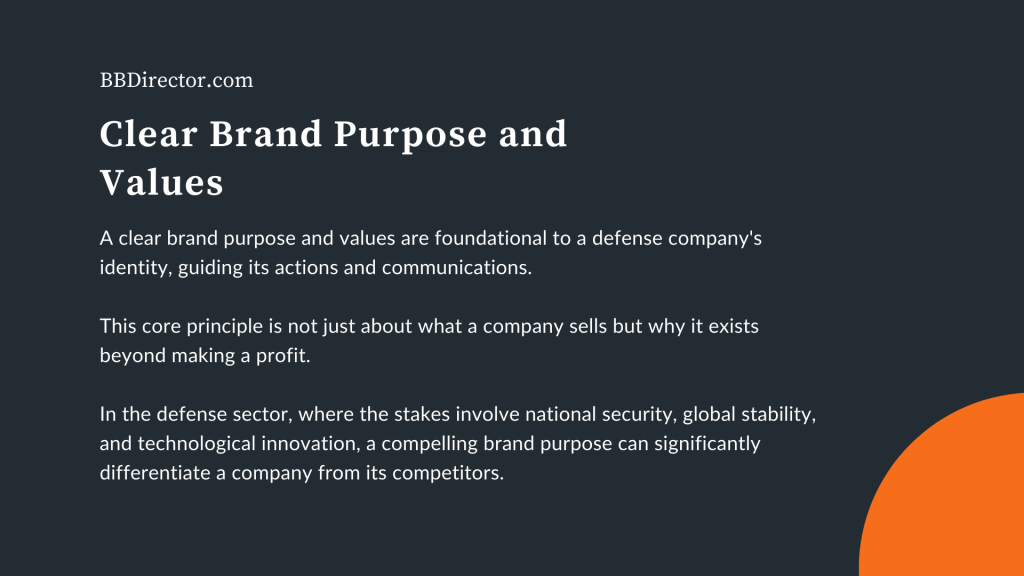
A clear brand purpose and values are foundational to a defense company’s identity, guiding its actions and communications.
This core principle is not just about what a company sells but why it exists beyond making a profit.
In the defense sector, where the stakes involve national security, global stability, and technological innovation, a compelling brand purpose can significantly differentiate a company from its competitors.
Research underscores the importance of brand purpose in building long-term relationships with customers and stakeholders.
A 2020 study by Zeno Group found that consumers are four times more likely to purchase from a company with a strong purpose.
Furthermore, employees are 4.5 times more likely to be engaged and motivated if they feel their company has a strong purpose beyond profit.
In the context of defense, a company’s brand purpose might center on enhancing global security, innovating for a safer future, or advancing technology for peacekeeping efforts.
This purpose should be deeply integrated into the company’s strategy, influencing product development, marketing, and corporate social responsibility (CSR) initiatives.
For example, Lockheed Martin’s commitment to “solving complex challenges, advancing scientific discovery, and delivering innovative solutions to help our customers keep people safe,” illustrates a clear alignment between their brand purpose and their operational focus.
Moreover, values such as integrity, innovation, and commitment to excellence are paramount in the defense industry, where trust and reliability are non-negotiable.
A 2019 Edelman Trust Barometer report highlighted that trust in a brand is a key deciding factor for consumers, with 81% of respondents stating they must trust the brand to do what is right.
Emphasizing a clear brand purpose and values is not just a moral imperative for defense companies; it’s a strategic one.
It builds trust, fosters loyalty, and aligns the organization’s efforts toward a common goal, which is crucial for long-term success in an industry that impacts the safety and security of societies worldwide.
Differentiation
Differentiation within the defense industry is pivotal for companies aiming to carve out a competitive edge in a sector characterized by high stakes and stringent regulations.
This differentiation can manifest through various facets, including technological innovation, product quality, customer service, and sustainability practices.
Technological innovation stands as a primary differentiator, with defense companies that lead in innovation capturing greater market share and achieving a competitive advantage.
A report by the Aerospace Industries Association underscores the critical role of innovation in the defense sector, highlighting that companies investing in next-generation technologies like artificial intelligence, unmanned systems, and cyber defense mechanisms not only lead the market but also drive the sector’s evolution.
Quality is another significant differentiator.
In an industry where the end products are crucial to national security, the reliability and performance of defense technologies cannot be compromised.
The International Organization for Standardization (ISO) emphasizes that quality management systems are essential for defense companies to consistently meet regulatory and customer requirements, thereby differentiating themselves in the market.
Customer service, particularly in terms of support and maintenance, offers another avenue for differentiation.
According to a study by Deloitte, defense contractors that provide exemplary after-sales service and support see increased customer loyalty and higher lifetime value from their contracts.
Sustainability has emerged as a unique differentiator in recent years.
A report by PwC highlighted that defense companies prioritizing sustainable practices, such as reducing environmental impact and ensuring ethical supply chains, not only meet increasing regulatory and societal expectations but also appeal to a broader range of stakeholders, including environmentally conscious investors and clients.
In essence, differentiation in the defense industry requires a multifaceted approach that encompasses innovation, quality, customer service, and sustainability.
Companies that excel in these areas are better positioned to stand out in a highly competitive and regulated market, ensuring long-term growth and profitability.
Stakeholder Engagement
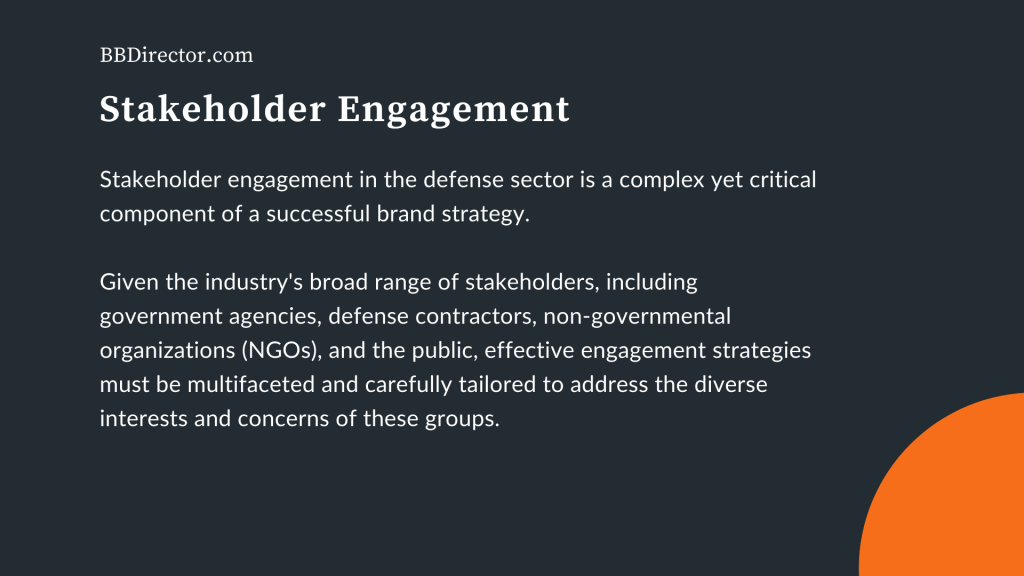
Stakeholder engagement in the defense sector is a complex yet critical component of a successful brand strategy.
Given the industry’s broad range of stakeholders, including government agencies, defense contractors, non-governmental organizations (NGOs), and the public, effective engagement strategies must be multifaceted and carefully tailored to address the diverse interests and concerns of these groups.
A key aspect of stakeholder engagement is transparency, particularly in government contracts and procurement processes.
The 2021 Edelman Trust Barometer reveals that transparency is a significant factor in building trust, with 53% of respondents stating that trust in a defense company would increase if it provided clear and transparent reporting on its operations and supply chain.
In an industry often scrutinized for secrecy and complexity, demonstrating openness about operations, sustainability efforts, and ethical practices can significantly enhance stakeholder trust and loyalty.
Engagement with NGOs and advocacy groups, especially those focused on ethical and sustainable practices, is increasingly important.
Collaborating with these organizations can help defense companies navigate the ethical complexities of the sector, improve their corporate social responsibility (CSR) initiatives, and communicate these efforts effectively to a broader audience.
Research by McKinsey underscores the value of such collaborations, indicating that companies actively engaging with NGOs on sustainability issues often achieve higher levels of innovation and stakeholder satisfaction.
Moreover, digital channels have revolutionized stakeholder engagement, offering new platforms for dialogue and interaction.
A study by Accenture highlights that B2B companies leveraging digital tools for customer engagement can significantly enhance customer satisfaction and loyalty.
For defense companies, utilizing social media, webinars, and online forums to share insights, innovations, and CSR efforts can foster stronger relationships with stakeholders, including the increasingly important millennial and Gen Z segments.
In summary, effective stakeholder engagement in the defense sector requires a strategic blend of transparency, collaboration with NGOs on ethical practices, and innovative use of digital platforms.
Companies that excel in these areas can build stronger, more trusting relationships with their stakeholders, paving the way for sustained success and positive brand perception.
Consistent and Coherent Brand Messaging
Consistent and coherent brand messaging is pivotal in the defense sector, where the clarity of a company’s mission, values, and offerings plays a crucial role in establishing trust and credibility.
In an industry characterized by high stakes and rigorous scrutiny, every communication and brand representation must be aligned to build a strong, reliable brand image.
A study by the Content Marketing Institute underscores the importance of content consistency, noting that organizations with consistent brand messaging are three to four times more likely to experience brand visibility and market growth.
For defense companies, this means ensuring that all marketing materials, proposals, product descriptions, and digital content convey a unified message that resonates with their core values and strategic objectives.
The psychological principle of the mere-exposure effect, which suggests that people tend to develop a preference for things merely because they are familiar with them, further highlights the importance of consistency.
A consistent brand message across all platforms reinforces brand recognition, making it easier for stakeholders to understand and trust the brand.
Lucidpress’s 2019 Brand Consistency Report found that consistent branding increases revenue by an average of 33%, demonstrating the tangible benefits of a coherent brand strategy.
Moreover, in the context of the defense industry, where the audience includes government agencies, private contractors, and the public, consistent messaging ensures that complex technologies and services are communicated clearly and effectively.
This clarity is essential for building trust with stakeholders who rely on defense companies for critical security solutions.
In conclusion, consistent and coherent brand messaging is not just about maintaining a uniform appearance; it’s about fostering trust, credibility, and recognition in a sector where these qualities are indispensable.
Defense companies that prioritize and execute consistent messaging across all touchpoints can significantly enhance their market position and stakeholder relationships.
Adaptability to Market Changes
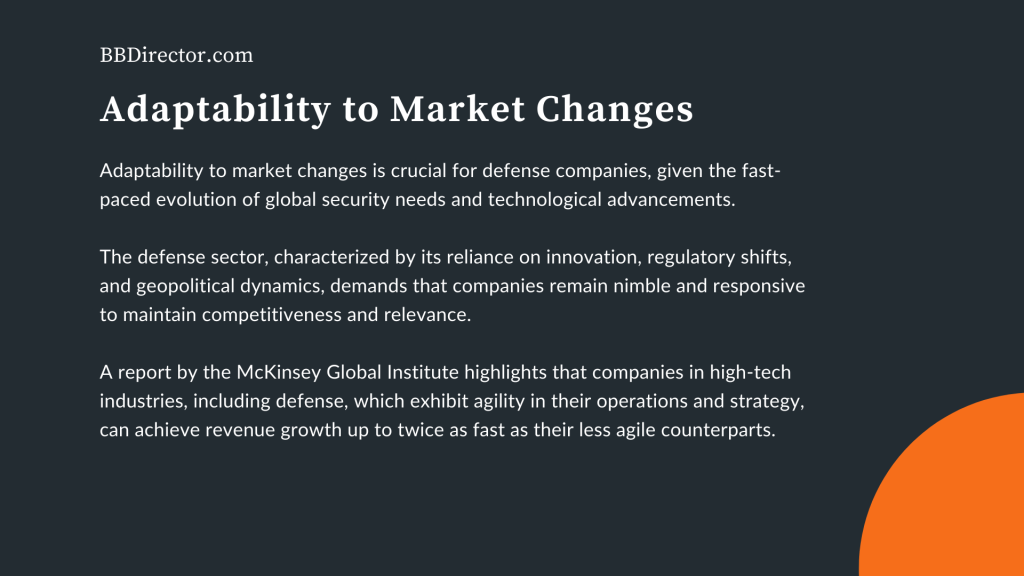
Adaptability to market changes is crucial for defense companies, given the fast-paced evolution of global security needs and technological advancements.
The defense sector, characterized by its reliance on innovation, regulatory shifts, and geopolitical dynamics, demands that companies remain nimble and responsive to maintain competitiveness and relevance.
A report by the McKinsey Global Institute highlights that companies in high-tech industries, including defense, which exhibit agility in their operations and strategy, can achieve revenue growth up to twice as fast as their less agile counterparts.
This agility enables firms to capitalize on emerging opportunities, adapt to regulatory changes, and innovate in response to shifting security landscapes.
Furthermore, the increasing role of cybersecurity threats and the integration of digital technologies into defense systems underscore the need for adaptability.
A study by the Deloitte Center for Government Insights points out that defense companies must continuously evolve their cybersecurity strategies and product offerings to address new threats, demonstrating adaptability not just in product development but also in strategic focus.
Adaptability also extends to market entry and expansion strategies.
As global defense spending shifts and emerging markets become more prominent, companies must adjust their market strategies to tap into new opportunities.
The Stockholm International Peace Research Institute (SIPRI) reports that changes in global defense spending patterns necessitate a flexible approach to market engagement, allowing companies to pivot their focus in response to geopolitical and economic trends.
In essence, adaptability for defense companies involves a dynamic approach to innovation, market strategy, and operational flexibility.
It’s about being prepared to pivot and evolve in response to new technologies, market demands, and global security challenges.
Companies that embed adaptability into their DNA not only safeguard their current market position but also secure a path for future growth and relevance.
Thought Leadership
Thought leadership is a strategic asset for defense companies, setting them apart as influencers and experts in a sector where technological sophistication, security expertise, and strategic insights are highly valued.
This approach not only enhances brand prestige but also fosters trust and credibility among critical stakeholders, including government agencies, defense contractors, and end-users.
A study by LinkedIn and Edelman highlights the significant impact of thought leadership on B2B relationships, revealing that 55% of decision-makers use thought leadership as an important way to vet businesses.
In the defense sector, where decisions often involve substantial investments and long-term partnerships, demonstrating deep industry knowledge and foresight can substantially influence procurement choices and partnership opportunities.
Moreover, thought leadership transcends traditional marketing by providing valuable, insightful content that addresses complex challenges and future trends in defense technology and policy.
This could range from the implications of artificial intelligence in warfare to strategies for enhancing cyber resilience.
Such content not only showcases a company’s expertise but also contributes to the broader industry dialogue, positioning the company as a key player in shaping the future of defense.
Additionally, engaging in thought leadership activities such as publishing white papers, participating in industry panels, and conducting original research can enhance a company’s visibility and attract talent.
A report by Forbes notes that companies recognized as thought leaders attract better talent, due to the prestige associated with working for an organization that is at the forefront of its industry.
In conclusion, thought leadership in the defense sector is about leveraging expertise to influence industry standards, practices, and innovations.
It’s a powerful tool for building brand authority, fostering trust, and securing a competitive edge in an industry where credibility and expertise are paramount.
Defense companies that invest in thought leadership not only elevate their brand but also contribute significantly to the evolution of global defense strategies and technologies.
Digital Presence and Innovation
In the contemporary defense industry landscape, a robust digital presence and commitment to innovation are not merely advantageous but essential.
This significance is underscored by the digital transformation sweeping across sectors, fundamentally altering how companies interact with their clients, showcase their capabilities, and position themselves in the global market.
A 2020 study by Accenture on digital transformation in aerospace and defense highlights that companies embracing digital technologies not only streamline operations and reduce costs but also unlock new avenues for customer engagement and product development.
Digital tools like augmented reality for virtual product demonstrations, AI for predictive maintenance, and blockchain for secure supply chain management exemplify how digital innovation can enhance product offerings and customer experiences.
Moreover, a digital presence extends beyond the company website and social media; it encompasses a holistic online footprint that includes engaging content, interactive platforms, and digital communities.
The Deloitte Insights report on digital marketing effectiveness points out that B2B buyers today conduct a significant portion of their purchasing research online before ever contacting a sales representative.
For defense companies, this means that a strong, informative, and engaging digital presence is crucial for attracting and educating potential clients and partners.
Furthermore, digital platforms offer unique opportunities for storytelling, allowing defense companies to share their innovations, successes, and visions for the future in compelling ways.
Content Marketing Institute’s 2019 trends report reveals that content marketing, when executed well, significantly increases engagement, lead generation, and brand loyalty.
In sum, investing in digital presence and innovation allows defense companies to showcase their leadership, connect with a broader audience, and drive forward-thinking solutions in a rapidly evolving global security environment.
It’s a strategic imperative that enables defense companies to navigate the complexities of the modern world, demonstrate their capabilities in real-time, and engage with stakeholders in meaningful, impactful ways.
How does Brand Purpose and Values impact the brand strategy of a defence company?
Here’s how a clear brand purpose and values impact a defense company’s brand strategy across various areas:
| Impact Area | Description |
|---|---|
| Stakeholder Trust | A clear brand purpose and values foster trust among stakeholders, including government clients, partners, and the public, by demonstrating a commitment to more than just profits—such as innovation, ethics, and global security. |
| Market Differentiation | Articulating a unique brand purpose and adhering to strong values help defense companies stand out in a competitive market, highlighting their unique approach to addressing security challenges and their dedication to innovation and ethical practices. |
| Employee Engagement | A well-defined brand purpose and values resonate with employees, fostering a sense of pride and belonging. This can enhance motivation, loyalty, and productivity, as staff feel they are contributing to meaningful goals beyond financial success. |
| Customer Loyalty | Customers and clients are more likely to form long-term partnerships with companies whose brand purpose aligns with their own values and objectives, especially in the defense sector where long-term trust and reliability are paramount. |
| Regulatory Compliance | Clear values, particularly around ethics and sustainability, guide defense companies in navigating the complex regulatory environments of their industry, ensuring compliance and demonstrating leadership in corporate responsibility. |
| Innovation and Growth | A compelling brand purpose can drive innovation by focusing a company’s efforts on solving significant and meaningful challenges, leading to growth opportunities and the development of groundbreaking technologies and solutions in the defense sector. |
This table summarizes the critical ways in which a clear brand purpose and values contribute to strengthening a defense company’s brand strategy, affecting everything from stakeholder relations to innovation and market positioning.
How does differentiation impact the brand strategy of a defence company?
Here’s how differentiation impacts a defense company’s brand strategy across various areas:
| Impact Area | Description |
|---|---|
| Competitive Advantage | Differentiation through unique technologies, services, or sustainability practices gives defense companies a competitive edge, making them the preferred choice for government and private contracts over less distinctive competitors. |
| Brand Recognition | A differentiated brand identity, established through unique product offerings or market positioning, enhances brand recognition and recall among stakeholders, including potential clients, partners, and the broader public. |
| Pricing Power | Companies that successfully differentiate their offerings can command higher prices due to perceived unique value or superior quality, contributing to improved profitability and financial sustainability. |
| Customer Preference | Differentiation that aligns with customer needs and values (such as innovation, reliability, or sustainability) strengthens customer preference, leading to increased loyalty and repeat business. |
| Market Segmentation | Effective differentiation allows companies to target specific market segments more accurately, tailoring their products and marketing strategies to the unique needs and preferences of those segments, thereby optimizing market penetration. |
| Innovation and Development | A focus on differentiation drives continual innovation and development within the company, as it seeks to maintain its unique position in the market. This can lead to the creation of groundbreaking technologies and solutions that further reinforce the company’s differentiated status. |
This table summarizes the critical ways in which differentiation contributes to enhancing a defense company’s brand strategy, from securing a competitive advantage to fostering innovation and development.
How does Stakeholder Engagement impact the brand strategy of a defence company?
Here’s how stakeholder engagement impacts a defense company’s brand strategy across various areas:
| Impact Area | Description |
|---|---|
| Reputation Building | Active engagement with stakeholders such as government agencies, defense contractors, and the public builds a positive reputation, establishing the company as a trustworthy and reliable partner in the defense sector. |
| Feedback and Improvement | Engaging with stakeholders provides valuable feedback on products and services, enabling defense companies to make necessary improvements and innovate, ensuring they meet or exceed market expectations. |
| Market Insight | Direct interaction with stakeholders offers deep insights into current market trends and future needs, allowing companies to align their product development and marketing strategies more effectively with market demands. |
| Enhanced Transparency | Regular communication and transparency about operations, ethical practices, and sustainability efforts enhance stakeholder trust and confidence in the brand, which is crucial for defense companies operating in a sector where integrity is paramount. |
| Stronger Relationships | Stakeholder engagement fosters stronger relationships with clients, partners, and the community, leading to increased loyalty, repeat business, and potentially unlocking new opportunities and partnerships. |
| Crisis Management | Effective stakeholder engagement strategies improve a company’s ability to manage crises by establishing channels of communication that can be used to quickly address concerns, mitigate negative impacts, and maintain trust. |
| Social Responsibility | Engaging with stakeholders on social and environmental issues demonstrates a commitment to corporate social responsibility, which can enhance brand image, attract talent, and potentially open up new markets or opportunities among ethically conscious clients and consumers. |
This table summarizes the critical ways in which stakeholder engagement contributes to enhancing a defense company’s brand strategy, from building reputation and gathering feedback to fostering social responsibility and managing crises.
How does Consistent and Coherent Brand Messaging impact the brand strategy of a defence company?
Here’s how consistent and coherent brand messaging impacts a defense company’s brand strategy across various areas:
| Impact Area | Description |
|---|---|
| Brand Recognition | Consistent and coherent messaging across all platforms and communications enhances brand recognition, making it easier for stakeholders to identify and remember the company. |
| Trust and Credibility | Uniformity in brand messaging builds trust and credibility with stakeholders by reinforcing the company’s commitment to its values and mission, crucial in the defense sector where reliability is paramount. |
| Market Positioning | Clear and consistent messaging helps to firmly establish a defense company’s market positioning, highlighting its unique value proposition and differentiating it from competitors. |
| Customer Engagement | Coherent messaging engages customers more effectively, providing them with a clear understanding of what the company offers and how it addresses their needs and challenges, leading to increased engagement and loyalty. |
| Employee Alignment | Consistent brand messaging ensures that employees are aligned with the company’s goals, values, and strategies, fostering a strong internal culture and enabling employees to effectively communicate the brand’s message externally. |
| Simplified Decision Making | For government agencies and contractors making procurement decisions, clear and consistent messaging simplifies the evaluation process, making it easier to understand a company’s offerings and the benefits they provide. |
| Effective Crisis Communication | In times of crisis, consistent and coherent brand messaging is critical for managing stakeholder perceptions and maintaining trust. It ensures that all communications are aligned, reducing confusion and reinforcing the company’s commitment to transparency and accountability. |
This table summarizes the critical ways in which consistent and coherent brand messaging contributes to enhancing a defense company’s brand strategy, from building brand recognition and trust to ensuring effective crisis communication.
How does Adaptability to Market Changes Impact the brand strategy of a defence company?
Here’s how adaptability to market changes impacts a defense company’s brand strategy across various areas:
| Impact Area | Description |
|---|---|
| Innovation Leadership | Adaptability positions a defense company as a leader in innovation, able to swiftly incorporate new technologies and respond to emerging threats, setting the standard for the industry and securing a competitive edge. |
| Market Responsiveness | The ability to quickly respond to market changes ensures that defense companies can meet evolving customer needs and regulatory requirements, maintaining relevance and competitiveness in a dynamic global landscape. |
| Risk Mitigation | Adaptability enables companies to anticipate and respond to potential disruptions in supply chains, geopolitical tensions, or changes in defense spending, mitigating risks and ensuring operational continuity. |
| Strategic Partnerships | Being adaptable facilitates the formation of strategic partnerships and alliances, allowing companies to leverage complementary strengths, access new markets, and collaborate on innovative solutions in response to shifting security challenges. |
| Brand Resilience | Adaptability contributes to brand resilience by demonstrating a company’s commitment to staying at the forefront of defense technology and strategy, fostering trust and confidence among stakeholders during times of change. |
| Talent Attraction | Companies known for their adaptability attract top talent, as innovative and dynamic environments are more appealing to professionals looking to work on cutting-edge projects and contribute to meaningful change in the defense sector. |
| Customer Loyalty | Defense companies that adapt to changing market demands and customer expectations are more likely to retain customers and foster long-term loyalty, as they are seen as reliable and forward-thinking partners capable of addressing current and future security needs. |
This table summarizes the critical ways in which adaptability to market changes contributes to enhancing a defense company’s brand strategy, from fostering innovation leadership to building customer loyalty.
How does Thought Leadership Impact the brand strategy of a defence company?
Here’s how thought leadership impacts a defense company’s brand strategy across various areas:
| Impact Area | Description |
|---|---|
| Industry Authority | Establishing thought leadership positions a defense company as an authority in the industry, enhancing its credibility and reputation. This recognition as a knowledge leader attracts attention from government agencies, partners, and the media. |
| Competitive Differentiation | Thought leadership allows a company to differentiate itself by demonstrating deep insights, innovative solutions, and forward-thinking strategies, setting it apart from competitors who may not engage as deeply in the broader discourse of the defense industry. |
| Client Trust and Loyalty | By providing valuable, insightful content that addresses complex challenges and future trends, a company can build trust and loyalty among its clients, who come to rely on the company not just for products and services but for strategic guidance and vision. |
| Stakeholder Engagement | Thought leadership content encourages engagement with a wide range of stakeholders, including industry peers, potential clients, and policymakers, fostering discussions that can lead to new opportunities and collaborations. |
| Talent Attraction and Retention | Companies recognized as thought leaders attract employees who seek to work with innovators and contribute to leading-edge projects. This can also enhance employee retention, as staff are motivated by the company’s impact on the industry and its commitment to progress. |
| Market Influence | Thought leadership extends a company’s influence beyond direct marketing and sales efforts, allowing it to shape industry trends, influence policy discussions, and set standards within the defense sector. |
This table summarizes the critical ways in which thought leadership contributes to enhancing a defense company’s brand strategy, from establishing industry authority to extending market influence.
How does Digital Presence and Innovation impact the brand strategy of a defence company?
Here’s how digital presence and innovation impact a defense company’s brand strategy across various areas:
| Impact Area | Description |
|---|---|
| Brand Visibility | A strong digital presence enhances brand visibility, making it easier for potential clients and partners to discover and engage with the company online. This visibility is crucial in an era where digital channels are primary sources of information for both decision-makers and the public. |
| Customer Engagement | Digital innovation, through tools like virtual reality demos or interactive webinars, significantly improves customer engagement by providing immersive experiences and detailed insights into products and services, fostering a deeper connection with the brand. |
| Market Expansion | Digital channels break geographical barriers, allowing defense companies to reach a global audience and tap into new markets with ease. This expansion is vital for companies looking to diversify their client base and enter emerging defense markets around the world. |
| Operational Efficiency | Leveraging digital technologies in operations, from supply chain management to customer service, enhances efficiency and reduces costs. This not only improves profitability but also allows companies to pass benefits such as quicker turnaround times and better prices onto their clients. |
| Innovation Showcase | Digital platforms offer an unparalleled opportunity to showcase innovation, whether through detailed case studies, video demonstrations, or live-streamed events, highlighting a company’s technological advancements and expertise to a wide audience. |
| Data-Driven Strategy | A robust digital presence provides access to valuable data on customer behavior, market trends, and engagement metrics. This data can inform strategic decisions, from product development to marketing approaches, ensuring they are aligned with current demands and opportunities. |
This table summarizes the critical ways in which digital presence and innovation contribute to enhancing a defense company’s brand strategy, from improving brand visibility to enabling data-driven strategic decisions.
Step-by-Step Guide To Creating A Brand Strategy for A Defence Company
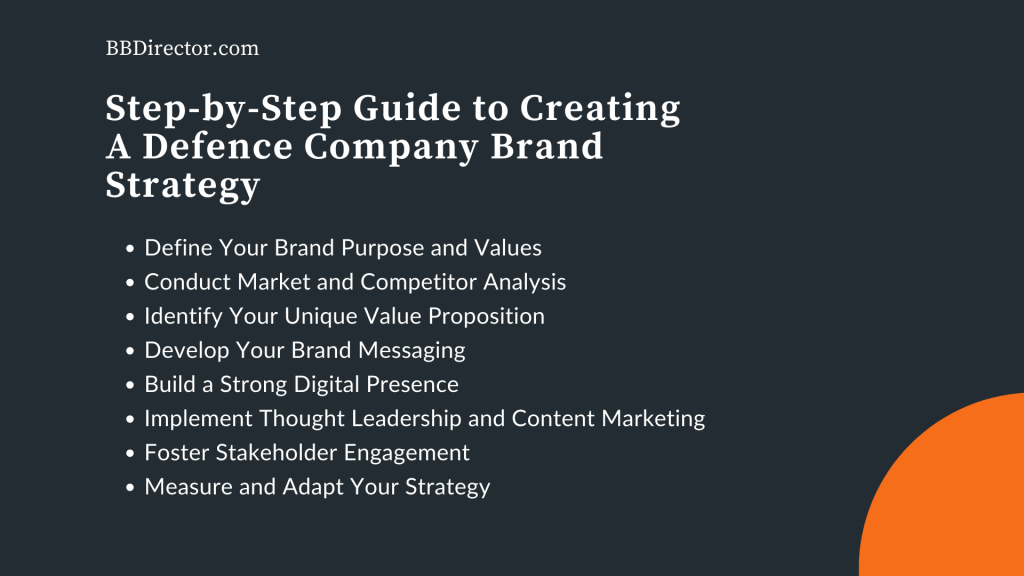
Creating a robust brand strategy is pivotal for defense companies navigating the complex landscape of global security, technological innovation, and shifting geopolitical dynamics. Here’s a step-by-step guide to crafting a brand strategy that positions a defense company for success:
1. Define Your Brand Purpose and Values
Start by articulating why your company exists beyond making a profit. What is your mission in the defense sector?
How do your products and services contribute to national security, global stability, or technological advancement?
Define the core values that guide your operations and interactions.
A study by Simon Sinek emphasizes the importance of starting with ‘why’ to inspire action and loyalty from both customers and employees.
Companies with a clear mission and values are more likely to attract stakeholders who share similar principles, fostering stronger relationships.
2. Conduct Market and Competitor Analysis
Analyze the current market trends, identify your main competitors, and understand the needs and preferences of your target audience.
This involves examining global defense spending, technological advancements, and regulatory changes.
Porter’s Five Forces framework provides a comprehensive method for analyzing competitive forces and the dynamics of the defense industry.
This understanding is crucial for identifying opportunities for differentiation and innovation.
3. Identify Your Unique Value Proposition
Based on your market and competitor analysis, pinpoint what makes your company unique.
Is it your cutting-edge technology, unparalleled expertise in a specific area, or commitment to sustainability and ethics?
According to a report by Bain & Company, companies that clearly articulate their value proposition are 120% more profitable than those that do not.
This differentiation is key to standing out in the competitive defense sector.
4. Develop Your Brand Messaging
Create a consistent and coherent brand message that communicates your brand purpose, values, and unique value proposition.
This message should resonate with your target audience and be consistently reflected across all your marketing and communication channels.
A study by McKinsey & Company highlights the importance of consistent brand messaging in building trust and loyalty among customers.
Consistency across all touchpoints can increase revenue by up to 23%.
5. Build a Strong Digital Presence
Develop a comprehensive digital strategy that includes an informative website, active social media profiles, and digital marketing campaigns.
Utilize digital platforms to showcase your innovations, share thought leadership content, and engage with stakeholders.
According to Google, B2B buyers conduct 12 searches on average before engaging with a brand’s website.
A strong digital presence ensures that potential clients find valuable information and positive impressions of your brand during their research phase.
6. Implement Thought Leadership and Content Marketing
Establish your company as a thought leader in the defense industry by creating and distributing insightful content.
This can include white papers on defense trends, blog posts on technological innovations, and participation in industry panels and discussions.
The Content Marketing Institute reports that 62% of successful B2B marketers have a documented content marketing strategy, which is instrumental in building brand authority and engagement.
7. Foster Stakeholder Engagement
Develop a plan for regular interaction with all your stakeholders, including customers, partners, and employees.
Use feedback mechanisms, conduct surveys, and engage in community initiatives to build relationships and trust.
A study by Gallup shows that companies with high levels of stakeholder engagement report 21% higher profitability.
Engaged stakeholders are more loyal and more likely to advocate for your brand.
8. Measure and Adapt Your Strategy
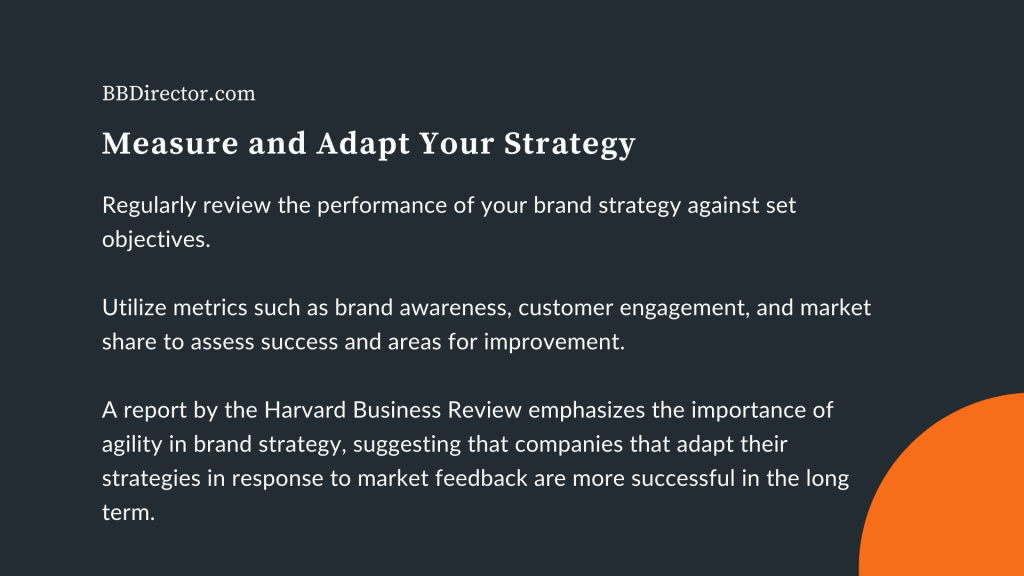
Regularly review the performance of your brand strategy against set objectives.
Utilize metrics such as brand awareness, customer engagement, and market share to assess success and areas for improvement.
A report by the Harvard Business Review emphasizes the importance of agility in brand strategy, suggesting that companies that adapt their strategies in response to market feedback are more successful in the long term.
This guide integrates research-backed actions to help defense companies navigate the complexities of brand strategy development, ensuring a cohesive approach that aligns with their mission, differentiates them in the market, and engages stakeholders effectively.
Now, let’s check out each one in detail.
Define Your Brand Purpose and Values
Defining your brand purpose and values is the bedrock of your brand strategy, especially in the defense sector where trust, reliability, and ethics are paramount.
Your brand purpose should articulate why your company exists beyond profit-making, highlighting your contribution to national security, technological innovation, or global stability.
This goes hand in hand with establishing core values that guide your business practices and interactions with stakeholders.
Research underscores the significance of a well-defined purpose and values in fostering stakeholder loyalty and engagement.
A seminal study by EY Beacon Institute and Harvard Business Review Analytic Services reveals that organizations with a strong sense of purpose are able to innovate more successfully, attract and retain talent more effectively, and achieve greater customer satisfaction.
These organizations are not just focused on what they do but more importantly, why they do it, driving every decision and strategy with a clear purpose that resonates with employees, customers, and the broader community.
This alignment between purpose, values, and business strategy is critical in the defense sector, where the implications of a company’s work are far-reaching and deeply impactful.
Let’s check each step in detail.
Hold on. Before you read on and spend weeks building a strategy…
Consider doing what 100s of CEO’s and founders did. Let me help you with your strategy and save 60+ hours of your time.
Book a 30 min, free, non obligatory callThe least you will get is 10 actionable tips & strategies, worth $5999, for free.
Superb
★★★★★“It was great working with Viktor! Thoughtful, strategic, great listener and really gets the client’s requirement. Highly recommend and hopefully can work together again soon. Definitely went above and beyond!”
Robin Singvi, CEO of SmartCue, a leading company developing products for go-to market teams worldwide.
Conduct Market and Competitor Analysis
Conducting a thorough market and competitor analysis is crucial for defense companies to navigate a landscape marked by rapid technological advancements, shifting geopolitical tensions, and evolving procurement practices.
This step involves a deep dive into current market trends, including changes in defense spending, emerging security threats, and technological innovations, as well as a comprehensive review of competitors’ strengths, weaknesses, and strategic directions.
Research by Frost & Sullivan highlights the importance of leveraging advanced analytics and intelligence tools for market analysis in the defense sector.
This approach enables companies to identify not only immediate opportunities and threats but also long-term trends that could impact market dynamics.
Moreover, competitor analysis, grounded in frameworks like SWOT (Strengths, Weaknesses, Opportunities, Threats), provides insights into the competitive landscape, helping companies to pinpoint areas for differentiation and strategic advantage.
By understanding the market’s direction and the competitive environment, defense companies can tailor their offerings to meet the current and future needs of their clients, anticipate market shifts, and position themselves as leaders in innovation and strategic thought.
This foundational knowledge is critical for strategic planning, helping companies to make informed decisions and prioritize initiatives that align with both market demands and their own capabilities and goals.
Identify Your Unique Value Proposition

Identifying a unique value proposition (UVP) is critical for defense companies to distinguish themselves in a highly competitive and complex market.
The UVP encapsulates what makes your company stand out, whether it’s unparalleled technological innovation, exceptional reliability and efficiency, or a strong commitment to ethical practices and sustainability.
Research underscores the significance of a clear UVP in influencing procurement decisions, especially in sectors like defense where differentiation can be nuanced.
A study by Bain & Company on value proposition clarity found that companies with a well-articulated UVP not only attract more customers but also foster deeper loyalty, as clients are more likely to engage with firms whose offerings are clearly aligned with their needs and values.
This clarity is particularly important in defense, where the stakes of procurement decisions are high, and buyers seek the assurance that their chosen providers can deliver superior, reliable solutions that meet stringent requirements.
For defense companies, articulating a UVP involves a deep understanding of the unique benefits their solutions offer, how these benefits address specific customer needs, and why they are preferable over competitors’ offerings.
It’s about succinctly conveying the distinctive value and advantages your company brings to the table, ensuring that this message resonates clearly with your target audience, from government entities to private contractors and beyond.
Develop Your Brand Messaging
Developing your brand messaging is a critical step that bridges the gap between your brand’s core identity and how it is perceived by the outside world.
Effective brand messaging communicates your value proposition, purpose, and values in a way that resonates with your target audience, compelling them to engage with your brand.
According to a study by the Journal of Brand Management, coherent brand messaging significantly enhances brand trust and loyalty.
This research suggests that customers are more likely to engage with and remain loyal to brands whose messages are clear, consistent, and align with their expectations and values.
In the defense sector, where trust is paramount, the impact of clear messaging is even more pronounced.
Defense companies must articulate their commitment to innovation, reliability, and security in every message they send, ensuring that their communications build confidence among stakeholders.
Effective brand messaging extends across all channels – from marketing materials and proposals to digital content and social media interactions.
It encapsulates the essence of the brand in a way that is both memorable and impactful, fostering a strong connection with the audience.
For defense companies, this means not only highlighting technical capabilities but also demonstrating their role in broader contexts such as national security and global peacekeeping efforts.
Build a Strong Digital Presence
Building a strong digital presence is essential for defense companies in today’s digital-first landscape.
A comprehensive digital strategy extends beyond a website to encompass social media, digital marketing, and online thought leadership platforms.
This multifaceted online presence enables companies to showcase their capabilities, innovations, and insights to a global audience, breaking down geographic and access barriers that traditionally limited market reach.
Research underscores the importance of a robust digital presence for B2B companies, including those in the defense sector.
According to a study by Google and Millward Brown Digital, nearly 90% of B2B buyers use online search in their research process, and over half of buyers are millennials, indicating a shift towards digital platforms for business research and decision-making.
For defense companies, leveraging digital channels to engage these tech-savvy buyers is crucial.
Digital platforms not only facilitate the showcasing of complex technologies and services through multimedia content but also enable real-time interaction and feedback, enhancing customer engagement and satisfaction.
Moreover, a strong digital presence supports SEO (Search Engine Optimization) efforts, making it easier for potential clients to find a company online when searching for relevant solutions.
This visibility is critical in a competitive market, helping defense companies stand out and effectively communicate their value propositions to potential clients, partners, and industry influencers.
Implement Thought Leadership and Content Marketing
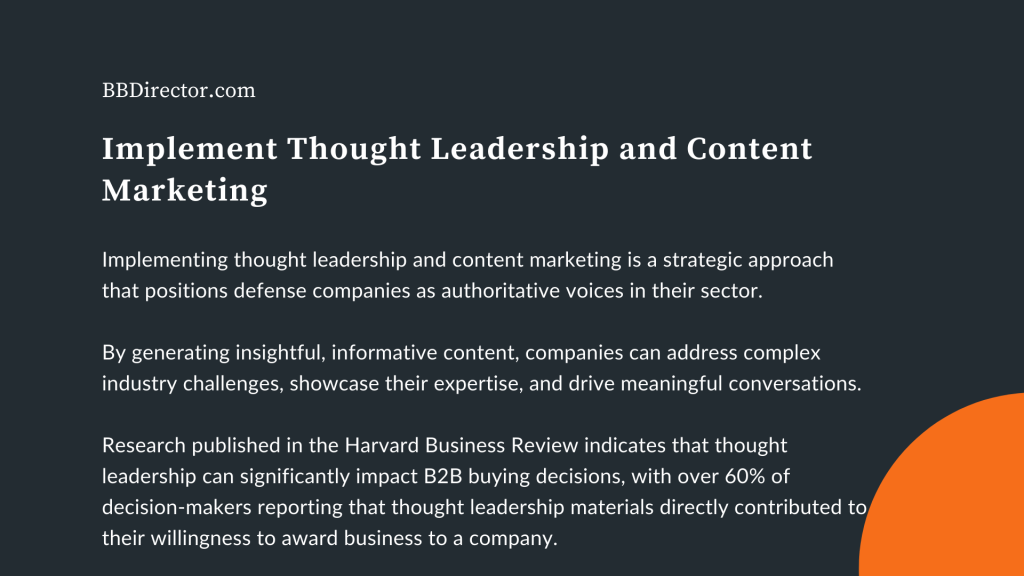
Implementing thought leadership and content marketing is a strategic approach that positions defense companies as authoritative voices in their sector.
By generating insightful, informative content, companies can address complex industry challenges, showcase their expertise, and drive meaningful conversations.
Research published in the Harvard Business Review indicates that thought leadership can significantly impact B2B buying decisions, with over 60% of decision-makers reporting that thought leadership materials directly contributed to their willingness to award business to a company.
In the defense sector, where the procurement process is intricate and decisions are heavily scrutinized, establishing thought leadership can differentiate a company as a trusted advisor and go-to source for innovative solutions.
Content marketing, when aligned with thought leadership, enhances this effect by distributing valuable content across various channels, engaging a broader audience.
A study by the Content Marketing Institute found that effective content marketing increases customer engagement and leads, with 72% of marketers reporting an increase in engagement through content marketing strategies.
For defense companies, thought leadership and content marketing are not just about promoting products or services but demonstrating their contributions to national security, technological advancement, and global stability.
This strategic content can foster trust, influence procurement decisions, and establish long-term partnerships.
Foster Stakeholder Engagement
Fostering stakeholder engagement is crucial for defense companies, as it strengthens relationships with key industry players, including government agencies, defense contractors, and end-users.
Effective engagement involves transparent communication, collaboration on projects, and active participation in industry discussions and events.
A study from the Journal of Business Ethics highlights the positive impact of stakeholder engagement on corporate reputation and trust, particularly in industries like defense, where ethical considerations and trust are paramount.
Engaging stakeholders not only improves a company’s image but also leads to better-informed decision-making, as feedback from diverse groups can unveil insights that might not be apparent from an internal perspective alone.
Moreover, according to research by McKinsey & Company, companies that excel at engaging their stakeholders achieve better outcomes in innovation, resilience, and financial performance.
For defense companies, this means that effective stakeholder engagement can lead to more successful project bids, stronger partnerships, and enhanced innovation through collaborative efforts.
Engaging stakeholders requires a commitment to regular, meaningful interactions and a willingness to listen and respond to concerns and feedback.
By prioritizing these relationships, defense companies can navigate the complex web of industry, governmental, and societal expectations, driving strategic growth and innovation.
Measure and Adapt Your Strategy
The “Measure and Adapt Your Strategy” step is pivotal for defense companies to ensure their brand strategy remains effective and responsive to market dynamics.
This involves setting clear metrics for success, regularly reviewing performance data, and being willing to pivot strategies based on these insights.
Research underscores the importance of this adaptability.
A study published in the Journal of Business Research indicates that firms that frequently review and adjust their strategies based on market feedback are more likely to sustain competitive advantage and achieve higher performance levels.
In the rapidly evolving defense sector, where technological advancements and geopolitical shifts can quickly change the landscape, this flexibility is even more critical.
Metrics such as brand awareness, market share, customer satisfaction, and engagement levels provide tangible data points to assess the effectiveness of a brand strategy.
Adapting strategy based on these metrics, as suggested by Harvard Business Review, allows companies to stay aligned with changing customer needs, regulatory environments, and competitive pressures, ensuring long-term success and relevance in the market.
Case Studies of Successful Defence Company Brand Strategies
A. Analysis of Successful Defense Companies
Lockheed Martin: Lockheed Martin’s branding strategy centers around its position as a leader in technology and innovation within the defense industry.
By focusing on cutting-edge technology and pioneering projects, such as the F-35 Lightning II fighter jet and the Mars Atmosphere and Volatile Evolution (MAVEN) spacecraft, Lockheed Martin has effectively communicated its brand as synonymous with aerospace excellence and innovation.
The company leverages a comprehensive digital presence, including an interactive website and social media channels, to showcase its projects and thought leadership, engaging stakeholders and reinforcing its brand message.
Raytheon’s brand strategy emphasizes its commitment to cybersecurity and advanced defense technologies.
Through thought leadership initiatives, including white papers and industry conferences, Raytheon has established itself as a go-to source for insights on digital warfare and cybersecurity challenges.
The company’s active engagement with stakeholders through digital platforms and community outreach programs further strengthens its reputation as a responsible and innovative defense leader.
B. Key Takeaways and Lessons Learned
Emphasize Innovation and Expertise: Successful defense companies like Lockheed Martin and Raytheon Technologies highlight their innovative capabilities and industry expertise in their branding.
This positions them as leaders in the sector and attracts partnerships and contracts.
Leverage Digital Platforms for Engagement: Utilizing digital channels to showcase technologies, share insights, and engage with stakeholders is a common trait among leading defense companies.
An active and informative digital presence helps build brand visibility and credibility.
Commitment to Ethical Practices: Demonstrating a commitment to ethical practices and sustainability resonates well with stakeholders, particularly in an industry scrutinized for its impact.
Transparency in operations and contributions to global security and stability are critical.
Adaptability is Key: The ability to adapt branding and marketing strategies in response to industry trends and global challenges is vital for sustained success.
Leading companies continuously evaluate and refine their strategies based on market feedback and shifts.
Invest in Thought Leadership: Investing in thought leadership content not only showcases a company’s expertise but also contributes to the broader industry dialogue, establishing the company as a trusted advisor in the defense sector.
In summary, successful defense company brand strategies are built on innovation, expertise, ethical practices, and active stakeholder engagement.
These companies demonstrate the importance of adaptability and thought leadership in reinforcing brand credibility and authority, offering valuable lessons for others in the sector.
Step-by-Step Guide To Creating An SEO Strategy For Defence Company

Creating a robust SEO content writing strategy for a defense company involves a careful blend of industry expertise, keyword research, and audience understanding to enhance visibility, engage stakeholders, and establish thought leadership.
Here’s a step-by-step guide to crafting an effective strategy:
1. Identify Target Audience and Their Needs
- Content: Define the primary audience segments (government agencies, contractors, defense experts) and their informational needs.
- Structure: Begin with audience segmentation, followed by a needs assessment for each segment.
- Research: Utilize market research reports and analytics data to understand audience demographics and interests.
- Importance: Tailoring content to the specific needs and search behaviors of your target audience increases relevance and engagement.
2. Conduct Keyword Research
- Content: Identify relevant keywords and phrases that your target audience uses in their online searches, focusing on terms related to defense technologies, services, and industry insights.
- Structure: List primary keywords, followed by secondary and long-tail keywords, categorizing them by audience segment and intent.
- Research: Use SEO tools like SEMrush or Ahrefs for keyword discovery and analysis.
- Importance: Keywords are critical for optimizing content for search engines, making your articles more discoverable by your target audience.
3. Develop Content Themes
- Content: Based on audience needs and keyword research, define several core content themes, such as innovation in defense technology, cybersecurity in military operations, and sustainable practices in defense manufacturing.
- Structure: Organize themes into a content calendar, outlining specific topics for articles, blog posts, and white papers.
- Research: Investigate current trends and challenges in the defense sector to ensure themes are timely and relevant.
- Importance: Thematic content creation ensures comprehensive coverage of topics important to your audience, establishing your brand as a knowledgeable authority.
4. Create Quality, Engaging Content
- Content: Produce well-researched, informative articles that incorporate targeted keywords naturally. Include insights from industry experts, case studies, and data analysis to add value.
- Structure: Use a structured approach with clear headings, short paragraphs, and bullet points for readability. Incorporate multimedia elements like images and videos to enhance engagement.
- Research: Reference authoritative sources, studies, and official reports to back up claims and provide depth.
- Importance: High-quality content improves user engagement, increases time on site, and encourages shares and backlinks, all of which positively impact SEO.
5. Optimize for SEO
- Content: Ensure all content is fully optimized for search engines, including meta titles, descriptions, headers, and alt text for images, using targeted keywords.
- Structure: Include an SEO checklist for each piece of content to ensure all optimization elements are addressed.
- Research: Follow best practices from Google’s Webmaster Guidelines for SEO optimization.
- Importance: SEO optimization makes content more visible on search engine results pages (SERPs), driving organic traffic to your site.
6. Measure and Adapt
- Content: Use analytics tools to track the performance of your content, including traffic, engagement metrics, and ranking improvements.
- Structure: Regularly review analytics data to identify trends, successes, and areas for improvement.
- Research: Analyze competitor content performance as a benchmark.
- Importance: Continuous measurement and adaptation ensure your content strategy remains effective and aligned with your audience’s evolving needs.
This guide highlights the critical steps in developing an SEO content strategy for defense companies, emphasizing the importance of research, audience understanding, and quality content in enhancing online visibility and engagement.
Step-by-step guide on branding your online/offline content for your defence company brand strategy
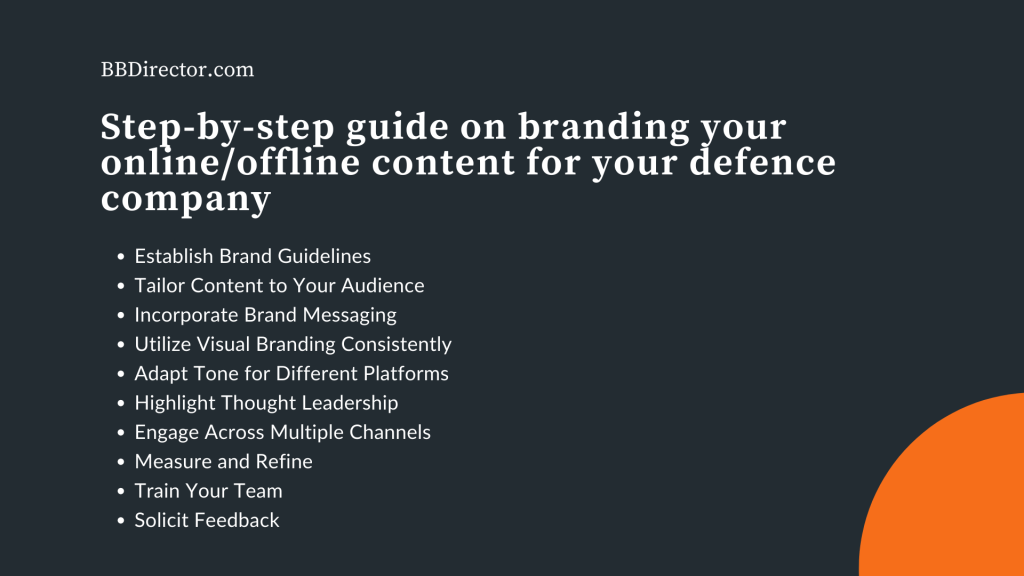
Branding your content effectively, both online and offline, is crucial for maintaining a cohesive and recognizable brand identity for defense companies.
Here’s a step-by-step guide to ensure your content reflects your brand strategy consistently across all platforms:
1. Establish Brand Guidelines
- Action: Develop comprehensive brand guidelines that include your brand’s mission, tone of voice, visual elements (logo usage, color palette, typography), and messaging pillars.
- Purpose: Ensures consistency across all content, reinforcing brand identity and values.
2. Tailor Content to Your Audience
- Action: Identify your primary and secondary audiences and tailor your content to address their specific needs, interests, and challenges.
- Purpose: Increases engagement and relevance, fostering trust and credibility with your target audience.
3. Incorporate Brand Messaging
- Action: Seamlessly integrate your brand messaging and values into every piece of content, from blog posts and white papers to social media updates and marketing collateral.
- Purpose: Reinforces your brand’s unique value proposition and key messages, enhancing brand recall.
4. Utilize Visual Branding Consistently
- Action: Apply your visual branding elements consistently in all content. This includes using your logo, brand colors, and typography according to your brand guidelines.
- Purpose: Visual consistency helps increase brand recognition and ensures a professional appearance across all platforms.
5. Adapt Tone for Different Platforms
- Action: Adjust the tone and style of your content to suit the platform it’s intended for, whether it’s a formal report for government stakeholders or a more casual blog post for the general public.
- Purpose: Maximizes the impact of your content by aligning with the expectations and preferences of the audience on each platform.
6. Highlight Thought Leadership
- Action: Create and distribute content that showcases your expertise and insights into the defense industry, such as trends, innovations, and challenges.
- Purpose: Establishes your brand as a thought leader, building trust and authority in your industry.
7. Engage Across Multiple Channels
- Action: Develop a multi-channel content strategy that includes both online (website, social media, email newsletters) and offline (conferences, print materials, direct mail) platforms.
- Purpose: Ensures comprehensive market coverage, increasing the visibility and impact of your brand.
8. Measure and Refine
- Action: Regularly review the performance of your content using analytics tools to assess engagement, reach, and conversion. Use these insights to refine your content strategy.
- Purpose: Allows for continuous improvement of content effectiveness and alignment with brand strategy.
9. Train Your Team
- Action: Conduct training sessions for your team on brand guidelines and best practices in content creation.
- Purpose: Ensures that everyone involved in content creation and distribution understands how to accurately represent the brand.
10. Solicit Feedback
- Action: Gather feedback from your audience and stakeholders on your content and its alignment with your brand identity.
- Purpose: Provides valuable insights that can help further refine and improve your content branding strategy.
By following these steps, defense companies can ensure their content not only supports their brand strategy but also resonates with their target audiences, driving engagement and building a strong, cohesive brand identity.
Ok let’s analyze each part.
Establish Brand Guidelines
Establishing brand guidelines is a critical initial step for defense companies aiming to create a cohesive and recognizable brand identity across all communication channels.
These guidelines serve as a comprehensive manual that details every aspect of how a company presents itself to the world, including its mission, values, tone of voice, visual elements (logos, color palette, typography), and messaging strategy.
Research underscores the importance of brand consistency in building trust and recognition among stakeholders.
A study by Lucidpress in “The State of Brand Consistency” report found that consistent brand presentation across all platforms increases revenue by up to 23%.
In the context of the defense industry, where trust and credibility are paramount, maintaining a consistent brand image can significantly impact a company’s ability to secure contracts and partnerships.
Moreover, brand guidelines ensure that every piece of content, whether a marketing brochure, a social media post, or an official report, reflects the company’s brand identity accurately and consistently.
This consistency helps in reinforcing the company’s unique value proposition and key messages, enhancing brand recall among the audience.
For defense companies, which operate in a highly regulated and competitive environment, brand guidelines also provide a framework for navigating complex communication challenges, ensuring that all content not only aligns with the brand’s identity but also adheres to industry regulations and standards.
This comprehensive approach to brand management, rooted in clear guidelines, is essential for establishing a strong, coherent brand presence both online and offline.
Tailor Content to Your Audience
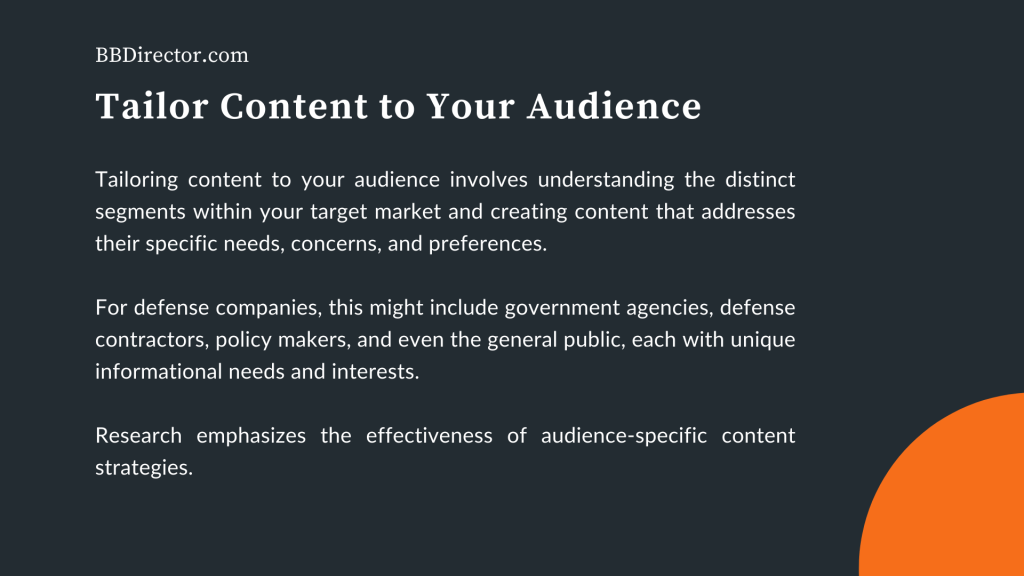
Tailoring content to your audience involves understanding the distinct segments within your target market and creating content that addresses their specific needs, concerns, and preferences.
For defense companies, this might include government agencies, defense contractors, policy makers, and even the general public, each with unique informational needs and interests.
Research emphasizes the effectiveness of audience-specific content strategies.
According to the Content Marketing Institute, content tailored to the specific interests of an audience segment is significantly more engaging and effective than generic content.
In the defense sector, where the audience ranges from highly technical engineers to policy-focused government officials, the importance of this tailored approach cannot be overstated.
For instance, technical audiences such as engineers and product developers may require in-depth analyses, technical specifications, and case studies that demonstrate the capabilities and applications of defense technologies.
On the other hand, policy makers and government officials might benefit more from content that outlines the strategic implications, cost-effectiveness, and compliance of defense solutions.
Moreover, a study by McKinsey & Company on personalization in digital marketing found that personalized content strategies can reduce acquisition costs by as much as 50% and increase marketing spend efficiency by 10-30%.
In the competitive and high-stakes environment of the defense industry, leveraging personalized content to engage specific audience segments can significantly enhance a company’s brand strategy, helping to build meaningful connections, trust, and credibility with each segment of the target market.
Incorporate Brand Messaging
Incorporating brand messaging into content involves embedding your company’s core messages, values, and propositions into every piece of communication, ensuring consistency and reinforcing your brand identity across all touchpoints.
This strategic embedding of brand messaging is vital for defense companies, where the clarity of mission, commitment to innovation, and assurance of security are paramount for establishing trust and credibility.
Research by Nielsen on the role of content in consumer decision-making found that consistent brand messaging across various platforms significantly enhances message retention and brand recall.
This consistency is crucial in the defense sector, where the decision-making process is lengthy and involves multiple stakeholders.
By consistently incorporating core brand messages into all content, defense companies can ensure that their value proposition is clearly understood and remembered by their target audience, from government procurement officers to defense contractors and end-users.
Additionally, a study published in the Journal of Marketing highlighted that brands with consistent messaging across their marketing channels enjoy a higher brand visibility and customer loyalty.
For defense companies, this consistency in brand messaging can translate to a competitive advantage, distinguishing them in a crowded market.
Effective incorporation of brand messaging requires a deep understanding of the company’s unique value propositions, such as technological superiority, reliability, ethical practices, or contributions to national and global security.
By weaving these messages into content narratives in a way that resonates with the target audience’s values and needs, defense companies can strengthen their brand perception, foster trust, and build lasting relationships with key stakeholders.
Utilize Visual Branding Consistently

Utilizing visual branding consistently across all content and communications is a strategic necessity for defense companies.
This visual consistency includes the use of logos, color schemes, typography, and imagery that align with the brand’s identity and values.
Visual branding acts as a visual cue, making a brand instantly recognizable, fostering brand recall, and building a sense of trust and reliability—qualities particularly crucial in the defense sector, where the stakes are high.
Research supports the importance of visual consistency in branding.
According to a study by the University of Loyola, Maryland, color increases brand recognition by up to 80%.
Furthermore, a report by Reboot found that consistent use of a signature color can increase brand recognition by 33%.
For defense companies, where differentiation in a saturated market is critical, these statistics underline the importance of maintaining a consistent visual brand identity.
Moreover, consistent visual branding extends beyond marketing materials to product design, trade show presentations, and even the company’s digital presence.
This consistency helps to weave a cohesive narrative about the brand, reinforcing its messaging and values without the need for explicit statements.
For defense companies, the strategic use of visual branding not only aids in distinguishing their offerings in a competitive market but also communicates the company’s commitment to professionalism, precision, and excellence.
By investing in a consistent visual identity, defense companies can ensure that their brand leaves a lasting impression on stakeholders, from potential clients and partners to government agencies, thereby enhancing their overall brand strategy.
Adapt Tone for Different Platforms
Adapting the tone of content for different platforms is a critical aspect of a comprehensive brand strategy, especially for defense companies navigating a diverse range of communication channels.
Each platform, from LinkedIn and Twitter to official reports and press releases, serves a unique audience segment with specific expectations regarding the formality and style of communication.
Research into audience preferences across platforms indicates that users expect content to align with the inherent culture and communication style of each platform.
A study published in the Journal of Marketing Communications found that content tone adaptation across platforms significantly impacts audience engagement and perception of authenticity.
For instance, LinkedIn users value professional and informative content, while Twitter users may appreciate more concise and timely updates.
Similarly, technical reports and white papers require a formal tone that conveys expertise and reliability, essential in the defense sector where credibility is paramount.
Furthermore, adapting tone can also enhance message effectiveness.
According to a report by the Content Marketing Institute, tailored content messaging that aligns with the specific platform and audience expectations can lead to higher engagement rates, increased brand loyalty, and improved conversion rates.
For defense companies, this strategic adaptation not only ensures that the content resonates with the intended audience but also reinforces the company’s brand identity as versatile and responsive to stakeholder needs.
By carefully adjusting the tone for each platform, defense companies can effectively communicate their value proposition, showcase their expertise, and engage with a broad spectrum of stakeholders, from industry experts and partners to government clients and the public.
Highlight Thought Leadership
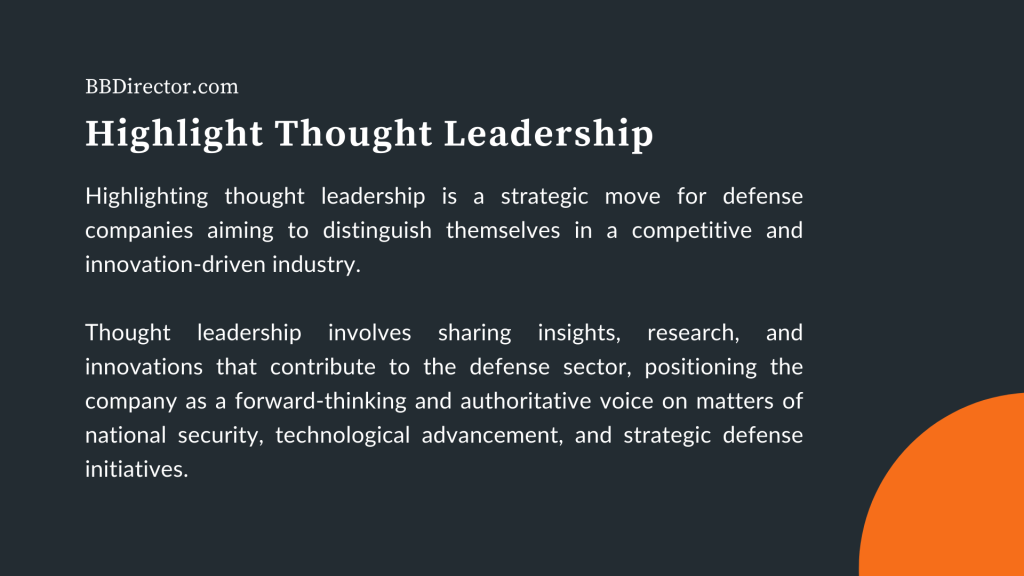
Highlighting thought leadership is a strategic move for defense companies aiming to distinguish themselves in a competitive and innovation-driven industry.
Thought leadership involves sharing insights, research, and innovations that contribute to the defense sector, positioning the company as a forward-thinking and authoritative voice on matters of national security, technological advancement, and strategic defense initiatives.
A study by Edelman and LinkedIn on thought leadership’s impact reveals that high-quality thought leadership content can significantly enhance brand reputation, with 89% of decision-makers saying it can be effective in enhancing their perceptions of an organization.
Moreover, the same study found that 49% of C-suite executives have awarded business to an organization based on their thought leadership.
In the defense sector, where the procurement process involves careful consideration and trust is paramount, becoming a recognized thought leader can directly influence business opportunities and partnerships.
Furthermore, thought leadership is not just about showcasing company achievements; it’s also about contributing to important industry conversations, addressing emerging global security challenges, and proposing innovative solutions.
This approach not only builds credibility but also demonstrates the company’s commitment to advancing the industry and addressing complex global threats.
For defense companies, investing in thought leadership—through publishing white papers, participating in panel discussions, and contributing to industry publications—can significantly impact their strategic positioning.
It helps in building a reputation as an innovator, attracts talent, and fosters trust with clients, stakeholders, and the wider community, ultimately driving competitive advantage and business growth.
Engage Across Multiple Channels
Engaging across multiple channels is a multifaceted strategy essential for defense companies to effectively communicate with their diverse audience, ranging from government decision-makers and industry partners to the general public.
This approach ensures that the brand’s message reaches stakeholders wherever they are most active, whether online or offline, enhancing visibility and engagement.
Research supports the efficacy of multi-channel engagement.
According to a study by Harvard Business Review, customers who engage with companies through multiple channels tend to be more loyal and spend up to 10% more on average compared to those who use a single channel.
In the defense sector, leveraging a variety of channels—from traditional media and industry conferences to digital platforms like LinkedIn, specialized defense forums, and corporate blogs—can significantly widen a company’s reach and reinforce its brand message.
Moreover, a multi-channel strategy allows for the tailoring of messages to fit the specific context and audience of each platform, increasing the relevance and impact of the communication.
For example, while LinkedIn can be used for sharing professional insights and networking, Instagram or YouTube might serve better for showcasing technology demonstrations and company culture, appealing to a broader audience, including potential recruits and the wider public.
Furthermore, engaging across multiple channels facilitates a more comprehensive feedback loop, providing valuable insights into audience preferences and content performance.
This data can inform future content strategies, ensuring that the company remains responsive to stakeholder needs and market dynamics.
For defense companies, a well-executed multi-channel engagement strategy not only amplifies their message but also builds a more resilient and adaptable brand presence in a rapidly evolving global security landscape.
Measure and Refine
The “Measure and Refine” step is crucial in a defense company’s branding and content strategy, emphasizing the importance of analytics and continuous improvement.
This process involves regularly assessing the performance of branding and marketing initiatives against set objectives, using quantitative and qualitative data to inform strategic decisions.
A study in the Journal of Marketing found that companies employing data-driven decision-making saw a 15-20% improvement in marketing efficiency and effectiveness.
In the context of defense companies, this could translate into better-targeted communications, higher engagement rates, and improved return on investment (ROI) for marketing campaigns.
Metrics such as website traffic, social media engagement, conversion rates, and audience feedback provide insights into what content resonates with the target audience and areas where the strategy may need adjustments.
Moreover, refining the strategy based on measured outcomes is aligned with agile marketing principles, which advocate for rapid iterations based on feedback and data.
This approach is particularly relevant in the fast-evolving defense industry, where companies must quickly adapt to new technologies, changing geopolitical landscapes, and evolving customer needs.
Refinement also means staying ahead of digital marketing trends, such as the growing importance of SEO, the impact of social media algorithms, and the potential of emerging platforms.
For defense companies, whose stakeholders range from government bodies to the general public, leveraging data to refine their strategy ensures that their messaging remains relevant, engaging, and aligned with their brand goals, ultimately enhancing their market position and brand perception.
Train Your Team
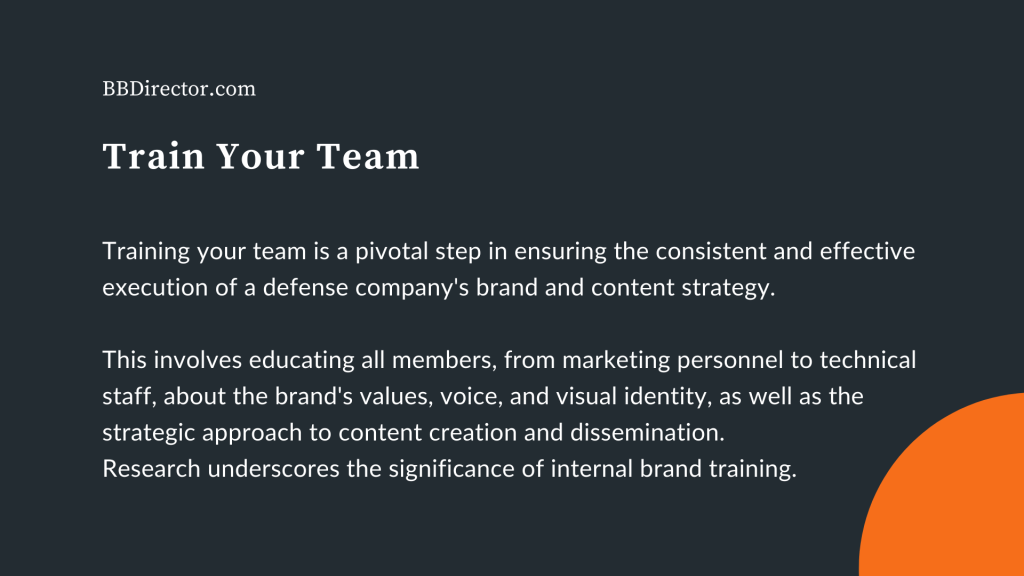
Training your team is a pivotal step in ensuring the consistent and effective execution of a defense company’s brand and content strategy.
This involves educating all members, from marketing personnel to technical staff, about the brand’s values, voice, and visual identity, as well as the strategic approach to content creation and dissemination.
Research underscores the significance of internal brand training.
A study published in the Journal of Brand Management reveals that employees who are well-versed in their company’s brand identity and strategy are more likely to deliver consistent brand experiences to customers.
For defense companies, where the complexity of products and services necessitates accurate and coherent representation, this internal alignment is crucial.
It ensures that every piece of content, whether a technical white paper or a social media post, accurately reflects the brand’s messaging and values.
Additionally, training empowers employees to become brand ambassadors. According to a LinkedIn report, employees of a company can collectively have social networks ten times larger than the company’s own social media channels.
By training employees on how to communicate about the company in line with the brand strategy, defense companies can leverage this extensive network for broader brand exposure and credibility.
Moreover, ongoing training programs can help keep the team updated on best practices in content marketing, SEO, and digital communication trends, essential in the rapidly evolving digital landscape.
For defense companies operating in a highly competitive and innovation-driven market, a well-trained team ensures that the brand’s strategic objectives are effectively communicated and achieved, enhancing overall brand strength and market position.
Solicit Feedback
Soliciting feedback is a critical component of refining a defense company’s brand strategy.
It involves actively seeking and analyzing feedback from various stakeholders, including customers, partners, and employees, to gain insights into the effectiveness of branding and communication efforts.
This feedback loop is essential for understanding stakeholder perceptions, identifying areas for improvement, and making informed adjustments to the brand strategy.
Research highlights the value of stakeholder feedback in brand development.
According to a study in the International Journal of Information Management, feedback mechanisms can significantly enhance customer satisfaction and loyalty by making customers feel valued and heard.
In the defense sector, where contracts are often large-scale and long-term, building and maintaining trust through responsive brand management is crucial.
Furthermore, feedback from internal stakeholders, such as employees, can provide unique perspectives on the brand’s strengths and weaknesses.
A study published in the Harvard Business Review emphasizes the role of employee feedback in uncovering blind spots in a company’s brand strategy, pointing to the need for internal alignment to ensure brand consistency across all touchpoints.
Soliciting feedback also aligns with continuous improvement methodologies, allowing defense companies to adapt their brand strategy in response to changing market dynamics, technological advancements, and evolving customer needs.
By establishing regular channels for feedback, such as surveys, focus groups, and social media interactions, companies can create a more agile and responsive brand strategy that resonates with both internal and external stakeholders, driving brand loyalty and competitive advantage.
Role Of Influencer Marketing In Defence
Influencer marketing, traditionally seen in consumer goods and services, can also play a strategic role in the brand strategy of a defense company.
However, its application in the defense sector requires a nuanced approach, focusing on thought leadership and professional influence rather than conventional social media influencers.
The Role of Influencer Marketing
1. Establishing Thought Leadership: Influencers in the defense sector are often respected experts, such as retired military personnel, defense analysts, or industry journalists.
Collaborating with these influencers to create content or co-host events can elevate a company’s stature as a thought leader and authoritative voice in the industry.
2. Enhancing Credibility and Trust: Endorsements or content collaborations with well-known defense experts can significantly enhance a brand’s credibility.
In a sector where trust and credibility are paramount, the association with esteemed figures can reinforce a company’s reputation for excellence and reliability.
3. Expanding Reach to Target Audiences: Defense influencers often have a dedicated following among key demographic groups, including industry professionals, government decision-makers, and defense enthusiasts.
Engaging with these influencers can help defense companies reach these targeted audiences more effectively than traditional marketing channels.
4. Supporting Recruitment Efforts: Influencer collaborations can also aid in showcasing the company’s culture, innovation, and commitment to security, appealing to potential recruits who value these attributes.
How to Use Influencer Marketing Effectively
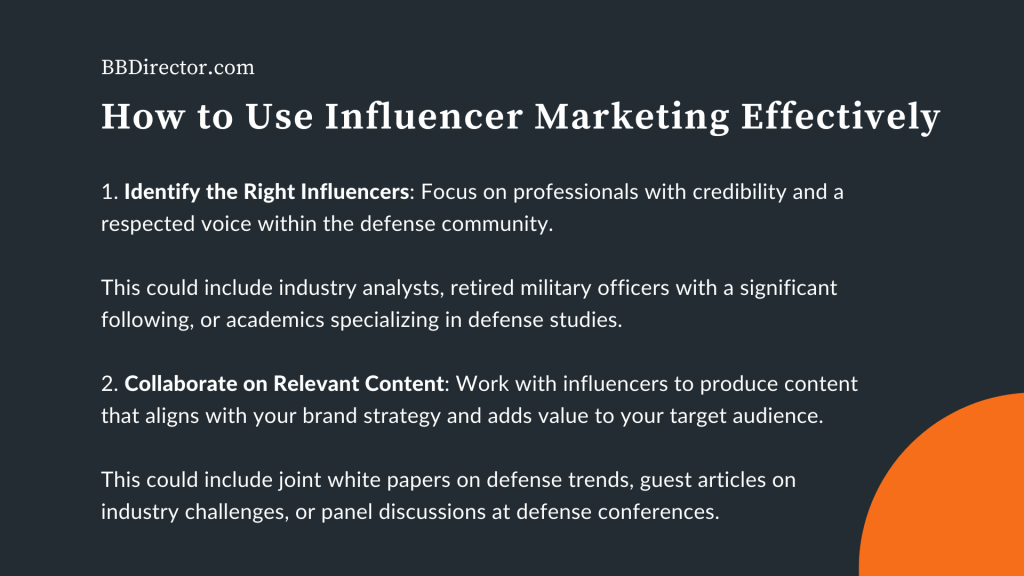
1. Identify the Right Influencers: Focus on professionals with credibility and a respected voice within the defense community.
This could include industry analysts, retired military officers with a significant following, or academics specializing in defense studies.
2. Collaborate on Relevant Content: Work with influencers to produce content that aligns with your brand strategy and adds value to your target audience.
This could include joint white papers on defense trends, guest articles on industry challenges, or panel discussions at defense conferences.
3. Leverage Influencers for Thought Leadership: Utilize influencers to amplify your company’s thought leadership content, such as research findings, innovative technologies, or insights into global security issues.
Their endorsement can increase the visibility and credibility of your content.
4. Measure Impact: As with all aspects of your brand strategy, it’s essential to measure the impact of influencer marketing efforts.
Track metrics such as engagement rates, website traffic from influencer collaborations, and changes in brand perception to gauge effectiveness.
5. Maintain Authenticity and Transparency: Ensure that any influencer collaborations are transparent and disclose the nature of the partnership.
Authenticity is crucial in maintaining trust, especially in the defense sector.
Influencer marketing in the defense sector is less about leveraging social media fame and more about engaging with individuals who can lend their expertise and authority to your brand.
By focusing on thought leadership and strategic collaborations, defense companies can use influencer marketing to enhance their brand strategy, build credibility, and engage more effectively with their target audiences.
Common Brand Pitfalls and How to Avoid Them
A. Common Mistakes When Developing a Brand Strategy for a Defence Companies
1. Inconsistent Brand Messaging: One of the most common pitfalls is the lack of consistency in brand messaging across different platforms and materials.
This can confuse stakeholders about the company’s values, capabilities, and identity.
2. Neglecting Digital Presence: Underestimating the importance of a robust digital presence can leave a defense company invisible in today’s digital-first world, where much of the preliminary research and decision-making happens online.
3. Overlooking Employee Engagement: Employees are the brand ambassadors. Failure to engage them in the brand’s vision and strategy can result in a disjointed experience for customers and stakeholders.
4. Ignoring Stakeholder Feedback: Not incorporating feedback from clients, partners, and the broader defense community can lead to a brand strategy that is out of touch with the market’s needs and expectations.
5. Failure to Differentiate: In the highly competitive defense market, failing to clearly articulate what sets the company apart from competitors can result in lost opportunities and market share.
Examples and Expert Advice on Risk Mitigation
Example of Failure: A notable defense company faced backlash for inconsistent messaging.
In their bid for a significant government contract, the discrepancy between their marketing materials and proposal content raised questions about their reliability, ultimately costing them the contract.
Expert Advice: Experts stress the importance of a unified brand strategy.
A study in the “Journal of Brand Management” suggests conducting regular brand audits to ensure all communications are aligned with the core brand message and values.
Tips and Advice on Avoiding These Pitfalls
1. Establish Comprehensive Brand Guidelines: Develop and rigorously implement brand guidelines that cover all aspects of messaging, visual identity, and employee engagement to ensure consistency.
2. Invest in Digital Strategy: Prioritize a digital strategy that encompasses an informative website, SEO, and active social media presence to improve visibility and engagement.
3. Engage and Train Employees: Regularly communicate the brand’s vision, values, and strategy to employees. Offer training to ensure they can effectively act as brand ambassadors.
4. Foster Open Channels for Feedback: Create mechanisms to gather and analyze feedback from all stakeholders, using insights to refine and adapt the brand strategy as necessary.
5. Clearly Articulate Your Unique Value Proposition (UVP): Focus on differentiating your brand by clearly communicating your UVP in all brand materials and proposals.
By acknowledging these common pitfalls and adopting a strategic approach to avoid them, defense companies can strengthen their brand strategy, enhance their market position, and build stronger relationships with stakeholders.
Implementing these practices requires diligence and ongoing evaluation but can significantly impact the company’s success and reputation in the defense sector.
The Future: Staying Agile
A. Upcoming Brand Strategy Trends and Technologies for Defense Companies
The future of brand strategy in the defense sector is poised to be shaped by several key trends and technologies.
First, digital transformation is expected to continue its ascendancy, with augmented reality (AR) and virtual reality (VR) technologies becoming increasingly utilized for product demonstrations and training modules.
These immersive experiences can significantly enhance brand engagement and comprehension of complex defense technologies.
Second, the integration of artificial intelligence (AI) in marketing strategies will enable more personalized and predictive marketing efforts.
AI-driven analytics can provide deeper insights into stakeholder behaviors and preferences, allowing for more targeted and effective brand messaging.
Third, sustainability and corporate responsibility are set to become more central in brand narratives.
As global awareness and regulations around environmental impact intensify, defense companies that can demonstrate a commitment to sustainable practices will likely gain a competitive edge.
B. The Importance of Agility and Adaptation
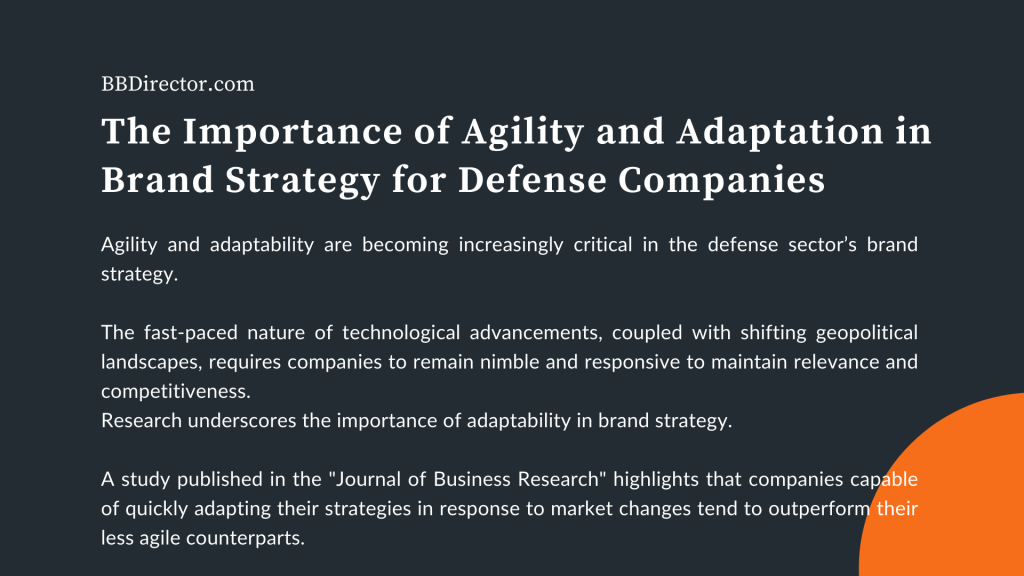
Agility and adaptability are becoming increasingly critical in the defense sector’s brand strategy.
The fast-paced nature of technological advancements, coupled with shifting geopolitical landscapes, requires companies to remain nimble and responsive to maintain relevance and competitiveness.
Research underscores the importance of adaptability in brand strategy.
A study published in the “Journal of Business Research” highlights that companies capable of quickly adapting their strategies in response to market changes tend to outperform their less agile counterparts.
In the context of defense, where the stakes involve national security and technological supremacy, the ability to pivot and evolve brand messaging and strategies is paramount.
Moreover, the COVID-19 pandemic has illustrated the critical need for agility in crisis situations.
Defense companies that quickly adapted their operations and communications in response to the pandemic were able to better navigate the challenges posed, underscoring the value of a flexible and responsive brand strategy.
Future Predictions and Expert Commentary
Experts predict that the defense sector will see an increased emphasis on collaborative brand strategies, with companies partnering with governments, NGOs, and even competitors to address global security challenges.
These collaborations can enhance brand prestige and trustworthiness.
Additionally, the rise of digital platforms and social media is expected to democratize brand building, with smaller defense companies leveraging these tools to challenge larger incumbents.
This shift will likely encourage innovation and competition within the sector.
In conclusion, the future of brand strategy for defense companies lies in embracing digital innovations, prioritizing sustainability, and maintaining agility.
By staying ahead of trends and being prepared to adapt to changing circumstances, defense companies can ensure their brand remains strong, relevant, and competitive in the evolving global landscape.
The Impact of AI on brand strategy
A. AI and Its Growing Relevance in Brand Strategy for Defense Companies
Artificial Intelligence (AI) is reshaping brand strategy in the defense sector by enabling more personalized, efficient, and data-driven approaches.
AI’s growing relevance is driven by its ability to process and analyze vast amounts of data quickly, uncovering insights that can inform strategic decisions, enhance customer engagement, and optimize marketing efforts.
B. Current Use of AI
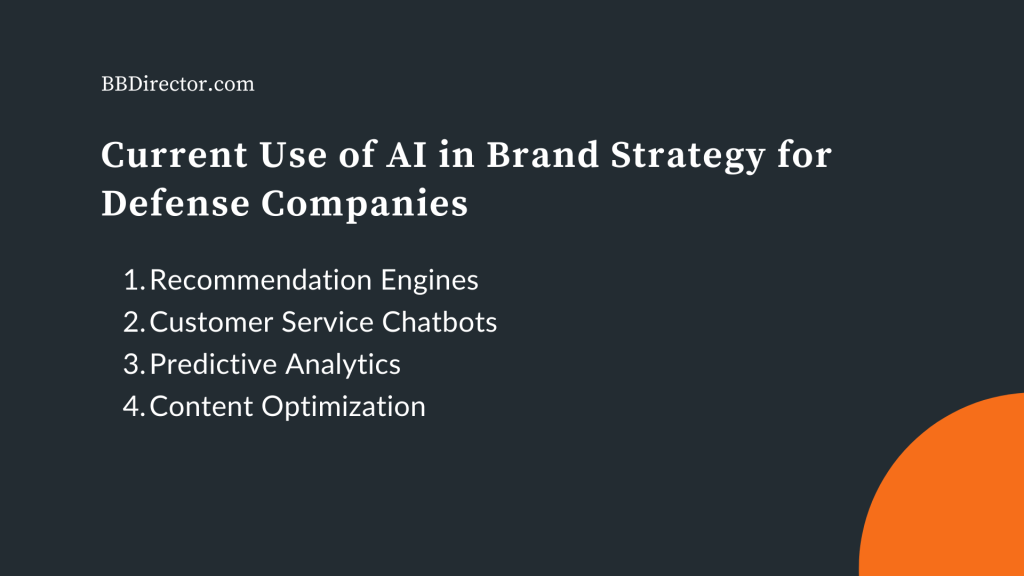
1. Recommendation Engines: AI-driven recommendation systems can tailor content and product suggestions to individual stakeholders, enhancing engagement and relevance.
2. Customer Service Chatbots: AI-powered chatbots provide instant, 24/7 assistance to users, improving customer experience and freeing human resources for more complex queries.
3. Predictive Analytics: Utilizing AI for predictive analytics allows defense companies to anticipate market trends, customer needs, and potential risks, facilitating proactive strategy adjustments.
4. Content Optimization: AI tools analyze user engagement and preferences to optimize content creation, distribution, and SEO strategies, ensuring higher visibility and engagement.
C. Benefits of AI
The incorporation of AI into brand strategy offers several benefits, including increased operational efficiency, enhanced personalization, deeper insights into customer behavior, and improved decision-making capabilities.
By leveraging AI, defense companies can ensure their branding efforts are both effective and scalable, maintaining a competitive edge in a rapidly evolving industry.
D. Implementing AI in Brand Strategies
Step 1: Assess Current Capabilities and Needs – Evaluate your company’s existing digital infrastructure and identify areas where AI can add value.
Step 2: Define Specific Objectives – Clearly articulate what you aim to achieve with AI, whether it’s improving customer engagement, enhancing personalization, or optimizing marketing ROI.
Step 3: Start with Pilot Projects – Implement AI in manageable, high-impact areas to assess its effectiveness and gather insights for wider deployment.
Step 4: Invest in Training – Ensure your team has the necessary skills and understanding to leverage AI tools effectively.
Step 5: Monitor and Refine – Continuously monitor AI-driven initiatives’ performance, using insights to refine and improve strategies over time.
E. Future Trends and Potential Applications of AI
Looking ahead, AI is expected to play an even more significant role in defense brand strategies.
Future trends include the use of AI for advanced sentiment analysis to gauge public perception, deep learning algorithms for hyper-personalized content creation, and AI-driven simulation tools for strategic planning.
Moreover, AI could enhance cybersecurity measures, protecting brand integrity in the digital realm.
As AI technology evolves, defense companies that successfully integrate AI into their brand strategies will likely lead the sector, offering superior stakeholder engagement, predictive insights, and strategic agility.
The key to success lies in adopting a proactive approach to AI, continuously exploring new applications and staying abreast of technological advancements.
Top 10 predictions
- Increased Digital Transformation: Defense companies will accelerate their digital transformation efforts, integrating advanced technologies such as AI, AR, VR, and IoT into their operations, marketing, and customer engagement strategies to enhance efficiency and offer immersive experiences.
- AI-Driven Personalization: The use of artificial intelligence to personalize marketing efforts will become more prevalent. AI will enable defense companies to tailor their communications and product recommendations with unprecedented precision, based on the analysis of individual stakeholder data.
- Sustainability as a Brand Pillar: As global awareness of environmental issues grows, defense companies will increasingly highlight their commitment to sustainability and ethical practices within their brand strategy, differentiating themselves in a competitive market.
- Evolving Cybersecurity Needs: With digital advancements, defense companies will face more sophisticated cybersecurity threats. Brand strategies will emphasize cybersecurity measures, reassuring stakeholders of the company’s commitment to protecting sensitive information.
- Enhanced Stakeholder Engagement Through Social Media: Social media will play a crucial role in engaging with a broader audience, including the next generation of talent and potential partners. Defense companies will leverage these platforms for thought leadership, recruitment, and corporate social responsibility initiatives.
- Rise of Collaborative Innovations: Collaborations between defense companies, technology startups, academic institutions, and even competitors will become more common, driven by the need to innovate rapidly and address complex global security challenges.
- Focus on Employee Advocacy: Recognizing the power of employees as brand ambassadors, defense companies will invest more in employee engagement and advocacy programs, leveraging their networks to amplify the brand’s reach and credibility.
- Adaptability to Geopolitical Shifts: Brands will need to remain highly adaptable to geopolitical changes, including regulatory shifts and changes in defense spending priorities, to navigate the complexities of the global defense landscape effectively.
- Virtual and Augmented Reality for Training and Simulation: The use of VR and AR for training programs and simulations will increase, offering more engaging and realistic experiences for military and defense personnel, while also being used in customer demonstrations.
- Direct Engagement with End-Users: There will be a shift towards more direct engagement with end-users, including military personnel and defense department officials, using digital tools and platforms to gather feedback, understand needs, and foster a community around the brand.
These predictions highlight the dynamic nature of the defense industry, emphasizing the importance of innovation, digital transformation, and stakeholder engagement in shaping future brand strategies.
Last but not least, some of our readers have asked us specific questions about the topic we discussed above, and we want to address them accordingly, and avoid any repercussions.
What is the importance of branding in the defence sector?
Branding plays a crucial role in the defence industry as it helps companies establish a strong brand identity, differentiate themselves from competitors, and build trust among potential customers.
How can public relations help improve brand reputation in the defence sector?
Public relations can play a key part in enhancing a company’s reputation in the defence industry by managing media channels, building relationships with stakeholders, and communicating effectively with the public.
Why is it important for defence SMEs to focus on branding and marketing?
For defence SMEs, having a strong brand and the right marketing plan is crucial for business development, attracting potential customers, and competing effectively in the market.
How can professional defence marketing services help enhance brand visibility?
Professional defence marketing services can help improve your brand’s presence through content development, search engine marketing, and targeted campaigns tailored to the defence sector.
Conclusion
As we look towards the future of brand strategy within the defense industry, it’s clear that the journey ahead is both challenging and exciting.
The landscape is evolving rapidly, driven by technological advancements, changing geopolitical dynamics, and a growing emphasis on sustainability and ethical practices.
For defense companies, staying ahead in this dynamic environment requires not just vigilance but a proactive approach to brand strategy.
Embrace the digital transformation with open arms. The digital realm offers unprecedented opportunities for engagement, innovation, and efficiency.
From leveraging AI for personalized marketing to utilizing social media for broader stakeholder engagement, the digital world is your oyster.
Remember, a robust digital presence is no longer optional; it’s imperative.
Sustainability and ethical practices are becoming critical differentiators in the marketplace.
Stakeholders are increasingly valuing companies that demonstrate a commitment to these principles.
Make sustainability and ethics core components of your brand identity, not just to stand out, but to contribute positively to global security and stability.
Never underestimate the power of adaptability and continuous learning.
The defense sector’s complexity and the pace of change demand a flexible approach to brand strategy.
Be ready to pivot, learn from feedback, and continuously refine your strategy based on insights and emerging trends.
Foster collaboration and engage deeply with your stakeholders.
From employees and government partners to the end-users of your technologies, each group offers unique perspectives that can enrich your brand strategy.
Open channels of communication and build a community around your brand.
Lastly, while the journey of crafting and executing a successful brand strategy in the defense industry is fraught with challenges, it is also filled with opportunities for growth, innovation, and leadership.
Stay informed, stay agile, and stay committed to your core values.
Your brand has the power not just to succeed in the marketplace but to make a meaningful impact on global security and defense.
In closing, approach your brand strategy journey with confidence, creativity, and a commitment to excellence.
The path ahead may be complex, but with a strategic approach, your brand can navigate the future successfully, achieving not just commercial success but contributing to a safer, more secure world.

